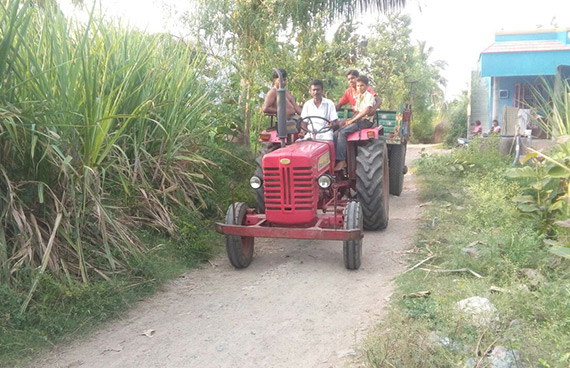The Road to Riches
Our Story
Life was tough without a usable road in our village of almost 240 people. Little children accompanied by elders had to use a path that cut through fields and watch out for snakes on their way to school. Farmers paid for their sugarcane, paddy, bananas and other produce to be carried as loads on heads, as there was no motorable road. Even the sick had to be carried by people up to a point if they wanted to access a road to reach the nearest hospital.
SST came to our village in 2004. As the needs of the village grew over the years, the SST team, like us, realised how much of a hindrance this lack of a 2-kilometer stretch of road was. Past efforts by villagers, including approaching the Block Development Officer and government agencies, failed to yield results.
The SST team took the initiative and had a meeting of all villagers, including community leaders. The villagers decided that they themselves would build the road to help save costs and ensure quality.
Of the total Rs. 200,000, most villagers including the key beneficiaries contributed Rs. 30,000 while SST gave the balance. It took a month to complete the gravel road, and it was ready in December 2014.
Today, minivans, tractors, and autos carrying schoolchildren ply on this road. SST helped change the situation around, otherwise people would migrate to Kerala to work on coffee plantations.
They also helped with an anganwadi, animal husbandry, arranging loans for ladies who are part of the self-help group, and for helping the elementary school in the village become a middle school.
The SST Way
Community Development Officer C. Loganathan who worked with villagers to make this gravel road a reality
This village suffered for a sheer lack of a gravel road. While we at SST helped in the areas of health, agriculture, animal husbandry, education and environment, the villagers saw the access road as the key to long-term prosperity.
The SST staff knew that children going to school even refused to go because of safety reasons, while farmers found it difficult, and expensive to get their produce out to markets for lack of a proper road. Even tractors and other equipment couldn’t make their way into most fields and, therefore, could not be used. So ploughing was done using buffaloes.
We decided to help these villagers in their efforts to build a 2-kilometer stretch of gravel road.
Trust built up over a period of time proved to be key. The villagers came to see SST members as part of their families. It wasn’t surprising that they came up with 30 percent of the money for the project and even decided to do it themselves.
The road is now a reality and has transformed the outlook for this village. Earlier, villagers would trek 5 kilometers to Malligapuram village, for most things. For instance, farmers who wanted to get their paddy threshed had to go there. For a banana bunch that sold for Rs. 75, the farmer had to part with Rs. 15 to get it across as a head load and place it in a van. Today, this costs just Rs. 2 to transport on a minivan using the new gravel road.
When these 240 families see us as a family and we see the happiness on their faces, it’s most satisfying.
Our Takeaways
A lot of development work in agriculture-based communities is about finding local cost-effective solutions.
It is important to first offer a holding hand so that people gain confidence to follow.
People’s mindsets are changing and they are taking the initiative for fulfillment of their needs.
